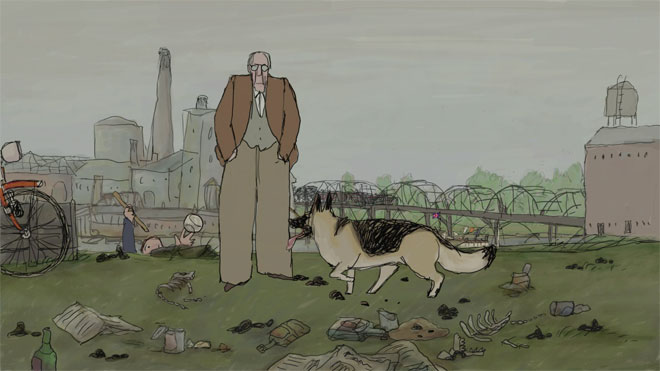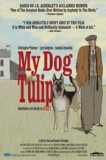| Reviews & Columns |
|
Reviews DVD TV on DVD Blu-ray 4K UHD International DVDs In Theaters Reviews by Studio Video Games Features Collector Series DVDs Easter Egg Database Interviews DVD Talk Radio Feature Articles Columns Anime Talk DVD Savant Horror DVDs The M.O.D. Squad Art House HD Talk Silent DVD
|
DVD Talk Forum |
|
|
| Resources |
|
DVD Price Search Customer Service #'s RCE Info Links |
|
Columns
|
|
|
My Dog Tulip

My Dog Tulip doesn't so much interpret J.R. Ackerley's loving and lovable short memoir as a filmed story, so much as it provides the book with moving illustrations. Animators Sandra and Paul Fierlinger share writing and directing credits here, their first feature-length film. Despite the charming and promising source material they have chosen to work with and the evocative power of their design sense, the Fierlingers don't do enough in terms of dramatizing Ackerley's story, choosing instead to stay dangerously close to the text (delivering much of it verbatim in the form of narration and dialogue), which stiffens the narrative from a cinematic perspective. English reserve and understatement were developed and perfected on the page; when read in voice-over (even by an actor as gifted as Christopher Plummer), the particular effects of these traits are diminished.
J.R. Ackerley was a major literary figure in mid-twentieth century England. He edited the BBC's literary journal, The Listener, for decades, and published several acclaimed books. One of these is My Dog Tulip (1956), a memoir that chronicles his relationship with a pet Alsatian (German Shepherd), a dog so difficult, loving, and demanding, that she consumed the vast majority of Ackerley's social and emotional life. Ackerley's book is a joy to read, an extremely witty and subtly touching story of a very unusual and deep friendship.
The Fierlingers' film places Ackerley (voiced by Plummer) and Tulip in a world in which animation only partially dramatizes the book's narrative. Most of the film is essentially silent, with voice-over narration drawn directly from the book being read over animated action. In other words, there is not much dialogue per se, just narration. Once in a while, other characters speak, such as Ackerley's sister Nancy (voiced by Lynn Redgrave) and the veterinarian Dr. Canvenini (voiced by Isabella Rossellini). For the most part, the story is expressed through the uncomfortable combination of off-screen narration and on-screen action, hence the impression that we're watching an illustrated novel instead of a full cinematic interpretation of the book.
Visually, the animation embraces a sketchy, throwback style that is not technically brilliant, but bears a coherent color palette, an intuitive design sense, and good composition. Tulip's movements are particularly realistic in the midst of human characters whose features are elongated and caricatured, which lends her an almost heightened level of emotion and expressiveness. The earthy colors capture the look of the English seasons, and the rubble, ruin, and rebirth of post-war London.
However, that still leaves the larger question of storytelling, and unfortunately, in its dramatics, My Dog Tulip is too static and stiff. The act of interpretation is usually what justifies a book's adaptation to film, and here the Fierlingers come up a little short. The film's narrative momentum rests solely with narration lifted directly from Ackerley's memoir, which renders the film version somewhat redundant. And beyond that bare fact, there's the trickier question of tone that I alluded to earlier. Ackerley's book comprises a delicate mix of dry English wit and understated tenderness that works extremely well on the page; transliterated to the somewhat abstracted medium of animation, some of that effect is sadly lost.
|
| Popular Reviews |
| Sponsored Links |
|
|
| Sponsored Links |
|
|
| Release List | Reviews | Shop | Newsletter | Forum | DVD Giveaways | Blu-Ray | Advertise |
|
Copyright 2024 DVDTalk.com All Rights Reserved. Legal Info, Privacy Policy, Terms of Use,
Manage Preferences,
Your Privacy Choices | |||||||











